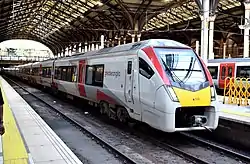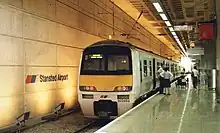Stansted Express
The Stansted Express is a direct train service linking London Liverpool Street to London Stansted Airport. It is a sub-brand of Greater Anglia, the current franchise operator of the East Anglia franchise.
 | |||||||||||||||||||||||||||||||||||||||||||||||||||||||
 A Greater Anglia Stansted Express Class 745/1 train at Liverpool Street station in 2021 | |||||||||||||||||||||||||||||||||||||||||||||||||||||||
| Overview | |||||||||||||||||||||||||||||||||||||||||||||||||||||||
|---|---|---|---|---|---|---|---|---|---|---|---|---|---|---|---|---|---|---|---|---|---|---|---|---|---|---|---|---|---|---|---|---|---|---|---|---|---|---|---|---|---|---|---|---|---|---|---|---|---|---|---|---|---|---|---|
| Franchise(s) | Part of Greater Anglia 15 October 2016 – 2025 Part of Abellio Greater Anglia 5 February 2012 – 15 October 2016 Part of National Express East Anglia 1 April 2004 – 4 February 2012 Part of West Anglia Great Northern 5 January 1997 – 31 March 2004 | ||||||||||||||||||||||||||||||||||||||||||||||||||||||
| Main Route(s) | Liverpool Street – Stansted Airport (West Anglia Main Line) | ||||||||||||||||||||||||||||||||||||||||||||||||||||||
| Fleet size | 10 Class 745/1 FLIRT | ||||||||||||||||||||||||||||||||||||||||||||||||||||||
| Stations called at | 5 | ||||||||||||||||||||||||||||||||||||||||||||||||||||||
| Parent company | Greater Anglia | ||||||||||||||||||||||||||||||||||||||||||||||||||||||
| Reporting mark | SX[1] | ||||||||||||||||||||||||||||||||||||||||||||||||||||||
| Technical | |||||||||||||||||||||||||||||||||||||||||||||||||||||||
| Length | 59.28421 km (36.83750 mi)[2] | ||||||||||||||||||||||||||||||||||||||||||||||||||||||
| Other | |||||||||||||||||||||||||||||||||||||||||||||||||||||||
| Website | www | ||||||||||||||||||||||||||||||||||||||||||||||||||||||
| |||||||||||||||||||||||||||||||||||||||||||||||||||||||
History

In 1986, British Rail (BR) extended the electrification of the West Anglia Main Line from Bishop's Stortford to Cambridge. Included in this plan was the construction of a new branch line—diverging from a triangular junction at Stansted Mountfitchet—to serve Stansted Airport, at which a new terminal was to open in 1991 providing for a large expansion in scheduled aviation passenger services. Therefore, BR decided to build a dedicated fleet of units to work the new Stansted Express service, designated as Class 322, with the service operated by the Network SouthEast sector.
Upon the privatisation of British Rail in 1996, the Stansted Express was part of West Anglia Great Northern franchise until the tender was reorganised in 2004, at which time it became part of the Greater Anglia franchise operated by one Railway (later renamed National Express East Anglia) until February 2012, when the franchise was taken over by the current operator Abellio Greater Anglia.
Operations
Unlike the Heathrow Express and the Gatwick Express (but like other services between London and Heathrow or Gatwick) the trains also stop at an intermediate station between London and the airport. The Stansted Express stops at Tottenham Hale (which provides interchange with the London Underground Victoria Line). The service takes between 47 and 56 minutes to London Liverpool Street, with trains departing every 15 or 30 minutes.[3]
Stansted Express offers several ticket types. In addition to the Single and Return tickets, percentage discounts are available for advance bookings, those travelling in pairs with WebDuo and groups with GroupSave. Every Stansted Express ticket comes with money-saving "2FOR1" (two-for-one) offers on some of London's favourite restaurants, shows and attractions like The London Eye, Madame Tussauds, the Sea Life Centre and Thorpe Park resort. Oyster or Contactless payment cards are not valid on Stansted Express services to/from Stansted Airport, but can be used between Liverpool Street and Tottenham Hale.
| Route | tph | Calling at |
|---|---|---|
| London Liverpool Street – Stansted Airport | 2 |
|
Criticism
Transport for London operates a pay-as-you-go system for public transport services. Passengers indicate the journey they are making by presenting a contactless payment card or Oyster card to readers at the start and end of the journey; the system then uses this information to automatically charge the appropriate fare. At stations fitted with ticket barriers, the readers are attached to the barriers and the barriers open when a valid card is presented.
Stansted Airport, being located some distance from London, is outside the area covered by this system, so PAYG cannot be used to travel there - instead, a ticket must be purchased. London stations served by the Stansted Express nonetheless have ticket barriers with readers for contactless and Oyster cards because they are also served by other trains on which PAYG can be used. This means it is possible for a passenger to board a Stansted Express train having entered the station using their card, and then travel to Stansted Airport, where they are charged a penalty for travelling without a valid ticket. This has led to accusations that Stansted Express is operating a scam by penalising passengers who are unaware that they have done anything wrong;[4] in 2019 it was reported that the number of penalty charges issued at Stansted Airport was 16,000 per year.[5]
Rolling stock
Current fleet
As part of the 1,300 new carriages to expand the UK's passenger rail fleet, Stansted Express was designated to receive 120 new vehicles. In February 2009, it was announced that Bombardier Transportation would produce the new trains.[6] Bombardier announced on 2 April that a contract had been signed for the delivery of the 120 coaches between December 2010 and March 2011.[7] The first of the new Class 379 units entered passenger service on 3 March 2011. The Class 379s were replaced by Class 745/1s, the first of which entered service on 28 July 2020.[8][9]
| Class | Image | Type | Top speed | Number | Routes operated | Built | |
|---|---|---|---|---|---|---|---|
| mph | km/h | ||||||
| 745/1 FLIRT |  |
EMU | 100 | 161 | 10 | Liverpool Street – Stansted Airport | 2018–2020 |
Past fleet
Stansted Express originally used a fleet of five Class 322 EMUs until it was decided to change to a dedicated fleet of nine Class 317/7 EMUs in 2000, further supplemented by twelve Class 317/8s in 2006. The displaced Class 322s were redeployed on several other routes/franchises around the country before settling into their former role in Scotland, working services between Glasgow/Edinburgh and North Berwick; they stayed there for some time before transferring to Northern Rail, working out of Leeds. They eventually returned into workings out of London Liverpool Street on the GEML, as Greater Anglia needed replacements for the Class 360s sent to EMR. They are planned to be put out of service by the end of 2022. Following the arrival of the new Class 379 units on Stansted Express services, the Class 317/8s were used alongside Class 317/5 and 317/6 units as a common pool. However, since Abellio took over the East Anglia franchise on 5 February 2012, all but one of the Class 317/7s have been scrapped.
| Class | Image | Type | Top speed | Number | Routes operated | Built | Withdrawn | |
|---|---|---|---|---|---|---|---|---|
| mph | km/h | |||||||
| 317/7 |  |
EMU | 100 | 160 | 9 | Liverpool Street – Stansted Airport | 1981–1982 | 2011 |
| 317/8 |  |
EMU | 100 | 160 | 12 | 1981–1982 | 2011 | |
| 322 |  |
EMU | 100 | 160 | 5 | 1990 | 2000 | |
| 379 Electrostar | .jpg.webp) |
EMU | 100 | 160 | 30 | 2010–2011 | 2020 | |
See also
References
- "National Rail Enquiries - Stansted Express". nationalrail.co.uk.
- https://sacuksprodnrdigital0001.blob.core.windows.net/sectional-appendix/Sectional%20Appendix%20full%20PDFs%20March%2023/Anglia%20Sectional%20Appendix%20March%202023.pdf
- Caswell, Mark (19 September 2023). "Stansted Express to return to four trains per hour throughout the day". Business Traveller. Retrieved 25 September 2023.
- "Stansted Express is rated "Bad" with 1.2 / 5 on Trustpilot". 18 October 2023.
- "16,000 rail travellers to Stansted fined after believing they could use Oyster card". 22 January 2019.
- "Hitachi to power new 'British' intercity trains and Bombardier to build 120 coaches". Rail News (Stevenage). 12 February 2009.
- https://finance.yahoo.com/news/Bombardier-Wins-a-188-Million-iw-14825741.html
- Holden, Michael (28 July 2020). "Brand new Stansted Express trains enter service in London". RailAdvent. Retrieved 28 July 2020.
- 2020-07-28T13:55:00+01:00. "Stansted Express Class 745/1 trainsets enter passenger service". Railway Gazette International. Retrieved 28 July 2020.